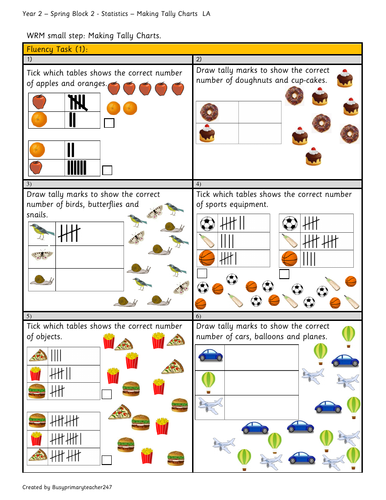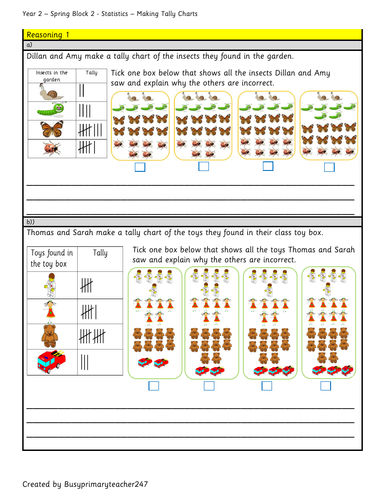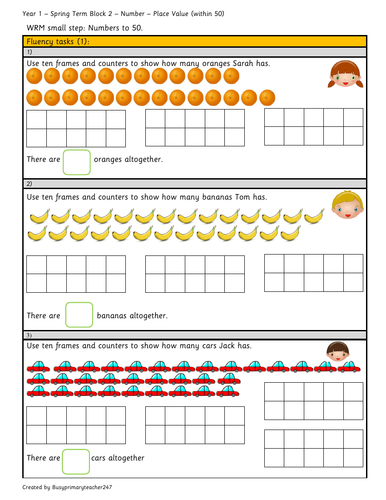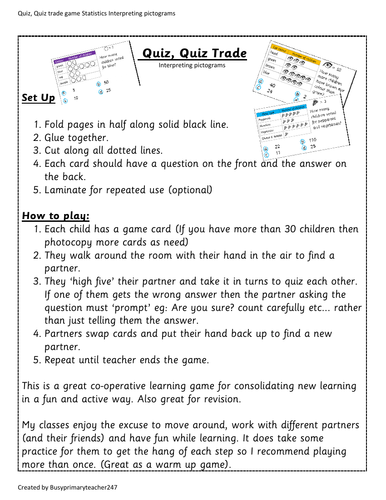132Uploads
174k+Views
66k+Downloads
All resources

Year 1-Place Value - One More, One Less. Quiz Quiz Trade Activity
This resource links to the Year 1, Plavce Value step of ‘Count One More, One less’. It includes 40 quiz cards that can be photocopied onto plain or coloured paper, plus instructions on how to setup and implement the activity.
Great as a whole class warm up or plenary activity. Children move around the cassroom and find a partner. Each partner takes it in turns to quiz the other using their card. They then trade cards and find a different partner. The activity continues until the teacher decides to stop. Helps aid consolidation of key lesson objectives.
Bundle

Year 1 Place Value 0-10 Bundle 1
This bundle follows the mastery approach to Year 1 place value (concrete - pictorial - abstract)linked to UK Autumn term, week 1, with a focus on the learning objectives: sorting objects, counting objects, representing objects and counting, reading and writing forwards from any number 0 to 10.
Resources included in this pack:
Power point presentations
Working wall display items
Student worksheets differentiated lower ability, age related, greater depth (plus answers)
Reasoning and problem solving
Curriculum Links:
UK:
Identify and represent numbers using objects and pictorial representations including the number line, and use the language of equal to, more than, less than (fewer), most, least.
Count, read and write numbers to 10 in numerals and words.
Count to ten, forwards and backwards, beginning with 0 or 1, or from any given number.
Australia:
ACMNA012 Develop confidence with number sequences to and from 100 by ones from any starting point.
ACMNA013 Recognise, model, read, write and order numbers to at least 100. Locate these numbers on a number line. Modelling numbers with a range of material and images. Identifying numbers that are represented on a number line and placing numbers on a prepared number line.
American Common Core Standards
CCSS.MATH.CONTENT.K.CC.B.4 Understand the relationship between numbers and quantities; connect counting to cardinality.
CCSS.MATH.CONTENT.K.CC.A.1 Count to 100 by ones and by tens.
CCSS.MATH.CONTENT.1.NBT.A.1 Count to 120, starting at any number less than 120. In this range, read and write numerals and represent a number of objects with a written numeral
Bundle

Year 1 Place Value 0-10 Bundle 2
This bundle follows the mastery approach to Year 1 place value (concrete - pictorial - abstract)linked to UK Autumn term, week 1, with a focus on the learning objectives: sorting objects, counting objects, representing objects and counting, reading and writing forwards from any number 0 to 10.
Resources included in this pack:
Power point presentations
Working wall display items
Student worksheets differentiated lower ability, age related, greater depth (plus answers)
Reasoning and problem solving
Curriculum Links:
UK:
Identify and represent numbers using objects and pictorial representations including the number line, and use the language of equal to, more than, less than (fewer), most, least.
Count, read and write numbers to 10 in numerals and words.
Count to ten, forwards and backwards, beginning with 0 or 1, or from any given number.
Australia:
ACMNA012 Develop confidence with number sequences to and from 100 by ones from any starting point.
ACMNA013 Recognise, model, read, write and order numbers to at least 100. Locate these numbers on a number line. Modelling numbers with a range of material and images. Identifying numbers that are represented on a number line and placing numbers on a prepared number line.
American Common Core Standards
CCSS.MATH.CONTENT.K.CC.B.4 Understand the relationship between numbers and quantities; connect counting to cardinality.
CCSS.MATH.CONTENT.K.CC.A.1 Count to 100 by ones and by tens.
CCSS.MATH.CONTENT.1.NBT.A.1 Count to 120, starting at any number less than 120. In this range, read and write numerals and represent a number of objects with a written numera

Yr 3 Multiplication and Division Equal Groups
Year 3 Number: Multiplication & Division - Equal Groups
Incl. Varied Fluency, Reasoning & Problem Solving
This resource is differentiated 3 ways and follows the concrete-pictorial-abstract method of Maths Mastery. The worksheets recap understanding of recognising, making, and adding equal groups and build on prior learning. Children are encouraged to consider what is the same and what is different between groups, what each digit in a number sentence represents and to show different ways of representing groups.
Links to National Curriculum:
Count from 0 in multiples of 4, 8, 50 and 100.
Recall and use multiplication and division facts for the 3, 4 and 8 multiplication tables.
Write and calculate mathematical statements for multiplication and division using the multiplication tables they know, including for two-digit numbers times one-digit numbers, using mental and progressing to formal written methods.
Solve problems, including missing number problems, involving multiplication and division, including positive integer scaling problems and correspondence problems in which n objects are connected to m objects.
Pictures used in this resource have been created by Busyprimaryteacher247
Other images sourced from - https://wpclipart.com

Yr 3 Number: Dividing by 3
Year 3 Number: Multiplication & Division – Dividing by 3 Varied Fluency & Reasoning.
This resource is differentiated 3 ways and follows the concrete-pictorial-abstract method of Maths Mastery. The worksheets explore dividing by 3 through sharing into three groups and grouping in threes.
Links to National Curriculum:
Count from 0 in multiples of 4, 8, 50 and 100.
Recall and use multiplication and division facts for the 3, 4 and 8 multiplication tables.
Write and calculate mathematical statements for multiplication and division using the multiplication tables they know, including for two-digit numbers times one-digit numbers, using mental and progressing to formal written methods.
Solve problems, including missing number problems, involving multiplication and division, including positive integer scaling problems and correspondence problems in which n objects are connected to m objects.
Pictures used in this resource have been created by Busyprimaryteacher247
Other images sourced from - https://wpclipart.com

Yr 3 Number: Multiplying by 3
Year 3 Number: Multiplication & Division – Multiplying by 3 Varied Fluency & Reasoning.
This resource is differentiated 3 ways and follows the concrete-pictorial-abstract method of Maths Mastery. The worksheets draw on knowledge of counting in threes in order to start to multiply by 3, and encourages children to use their knowledge of equal groups through using concrete and pictorial methods to solve multiplication problems.
Links to National Curriculum:
Count from 0 in multiples of 4, 8, 50 and 100.
Recall and use multiplication and division facts for the 3, 4 and 8 multiplication tables.
Write and calculate mathematical statements for multiplication and division using the multiplication tables they know, including for two-digit numbers times one-digit numbers, using mental and progressing to formal written methods.
Solve problems, including missing number problems, involving multiplication and division, including positive integer scaling problems and correspondence problems in which n objects are connected to m objects.
Pictures used in this resource have been created by Busyprimaryteacher247
Other images sourced from - https://wpclipart.com

Year 2 - WRM Spring Block 2 - week 3 - Making Tally Charts Fluency 1
Here is a free taster of the first fluency question page that links to WRM Maths Spring block 2 - Statistics. It is differentiated 2 ways.
Links directly to small step - Making tally charts
Enjoy x

Year 2 - Spring block 2 - week 3 - Statistics - Making tally charts (reasoning)
Here is a free taster of 2 reasoning question pages that link to WRM Maths Spring block 2 - Statistics.
Links directly to small step - Making tally charts

Area Dice Game
This is a great game for 1-2 players.
Equipment
-squared paper
-2 dice
-coloured pencils/ felt tips (textas)
Instructions
- Each player chooses a different coloured pencil / felt tip
- Players take it in turns to roll the dice.
- They use the number on each dice to colour in the number of squares, and write the area in the
middle of the shape.eg
- Game ends when players run out of room to draw.
- Winner is the player who has used the largest area/most squares.

Year 1 – Spring Block 2 – Number Place Value (Within 50) - week 5- numbers to 50
This resource follows the concrete-pictorial-abstract approach to Maths Mastery and also includes reasoning questions. It is linked to WRM small steps: Numbers to 50.
Curriculum links:
- Count to 50 forwards and backwards, beginning with 0 or 1, or from any number.
- Count, read and write numbers to 50 in numerals.
- Identify and represent numbers using objects and pictorial representations including the number line, and use the language of: equal to, more than, less than (fewer), most, least.
I hope you find this resource useful,
Your feedback is always welcome :)

Quiz, Quiz Trade activity cards - Interpreting pictograms
This is a great co-operative learning game for consolidating new learning in a fun and active way. Also great for revision.
My classes enjoy the excuse to move around, work with different partners (and their friends) and have fun while learning. It does take some practice for them to get the hang of each step so I recommend playing more than once. (Great as a warm up game).











